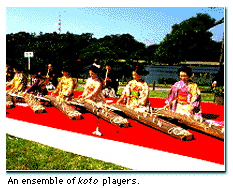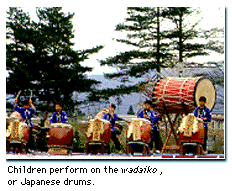 |
What kind of traditional musical instruments are there in Japan? |
 |
The shamisen is a lute-like stringed instrument that was adapted in the middle of the sixteenth century from a similar instrument used in the subtropical Ryukyu islands. The shamisen has a long fingerboard of about 1 meter (3.3 feet) attached to a box-like body and has three strings. The player plucks on these strings using a plectrum shaped like a ginkgo leaf. The player adjusts the pitch using pegs on the head.
The shakuhachi is an end-blown bamboo flute measuring about 55 centimeters (22 inches) in length. There are four holes in front and one in the back. The pitch is controlled by placing one's fingers completely or partially on the holes. The origins of the shakuhachi are uncertain, but historians say a prototype existed in Japan around the fourteenth century.
|
 | |
 Another traditional instrument is the zither-like
Another traditional instrument is the zither-like  Other traditional musical instruments include an hourglass-shaped hand-held drum called the tsuzumi, which developed in Japan after coming from China in the Nara period, and a type of mouth organ called the sho, used in ceremonial court music. The sho also came from China at about the same time.
Other traditional musical instruments include an hourglass-shaped hand-held drum called the tsuzumi, which developed in Japan after coming from China in the Nara period, and a type of mouth organ called the sho, used in ceremonial court music. The sho also came from China at about the same time.
